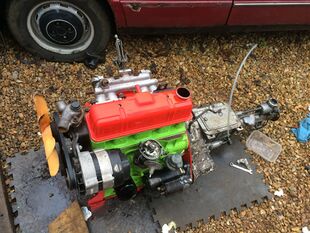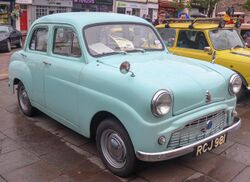Engineering:Triumph I4
| Triumph Inline 4 | |
|---|---|
 | |
| Overview | |
| Manufacturer | Standard Triumph
Leyland Motors British Leyland |
| Also called | Triumph OHV
Triumph 1300 Triumph 1500 |
| Production | 1953-1980 |
| Layout | |
| Configuration | Straight-4 |
| Displacement | 803 cc - 1493 cc |
| Block material | Iron |
| Head material | Iron |
| Combustion | |
| Fuel system | Carburettor |
| Cooling system | Water Cooled |
| Output | |
| Power output | 27 - 75 bhp |
| Chronology | |
| Predecessor | Standard 8 hp Sidevalve |
The Triumph Four Cylinder or Triumph I4 engine is a cast-iron overhead valve straight-four engine produced by Standard Triumph.Introduced in their Standard Eight in 1953, it was used in a wide range of Triumph vehicles, including the Triumph Herald, Triumph Spitfire and certain Dolomites.
Origin
Standard Eight engine
The Triumph inline four was first used in the Standard Eight in 1953. With a displacement of 803 cc the engine produced 26 bhp at 4500 rpm, by 1957 power has increased to 30 bhp at 5000 rpm.
Standard 10
In 1954 the Ten was introduced as a larger-engined, better-appointed version of the Standard Eight, though sharing a similar frame and transmission. The engine was a enlarged version of the inline 4 displacing 948 cc. A tail-finned (with optional two-tone paint schemes) version of the Ten, the Standard Pennant was launched in October 1957. This version of the engine had power increased to 37 bhp.
Triumph Herald & Spitfire
Most of the development of the engine happened in its run within the Herald and Spitfire range.
Herald & Herald S (948cc)
The initial engine used in the Triumph Herald was the Standard Pennant's 4-cylinder 948 cc OHV. Power was claimed as 34.5 bhp (25.7 kW).[1]
Herald 1200
Standard-Triumph experienced financial difficulties at the beginning of the 1960s and was taken over by Leyland Motors Ltd in 1961. This released new resources to develop the Herald and the car was re-launched in April 1961 with an 1147 cc engine as the Herald 1200. To gain the extra deplacement the cylinders were placed out of centre which cleared the studs so that a bigger bore could be used. This move gave a capacity of 1147 cc.[2] Twin carburettors were no longer fitted to any of the range as standard although they remained an option, the standard being a single down-draught Solex carburettor. Claimed maximum power of the Herald 1200 was 39 bhp (29 kW).[1] An upmarket version, the Herald 12/50, was offered from 1963 to 1967. It featured a tuned engine with a claimed output of 51 bhp (38 kW)[3]
Spitfire 4
The 1147 cc version of the engine was used in the first model of the Triumph Spitfire. Mildly tuned and fed by twin SU carburettors, in UK specification the in-line four produced 63 bhp (47 kW) at 5,750 rpm, and 67 lb⋅ft (91 N⋅m) of torque at 3,500 rpm.[4]
Further Boring
In 1965 The 1,147 cc engine was replaced with a bored-out 1,296 cc unit (the bore increasing from 69.3 mm (2.73 in) to 73.7 mm (2.90 in), stroke retained at 76 mm (3.0 in)), this was fitted on the new Triumph Herald 13/60 and Triumph 1300 saloons. First appearing in the Triumph 1300 it developed 61 hp (45 kW) with the single Stromberg CD150 carburettor, later in 1967 the Mk3 Spitfire utilised the engine in SU twin-carburettor form, putting out a claimed 75 bhp (56 kW) at 6,000 rpm, and 75 lb⋅ft (102 N⋅m) of torque at 4,000 rpm.
In 1970 with the introduction of the MK4 spitfire the 75 horsepower engine was now rated at 63 horsepower (for UK market employing the 9:1 compression ratio and twin SU HS2 carburetors; the less powerful North American version still used a single Zenith Stromberg carburetor and an 8.5:1 compression ratio) due to the German DIN system; the actual output was the same for the early Mark IV.The engine continued at 1296 cc, but in 1973 was modified with larger big-end bearings to rationalize production with the TR6 2.5 litre engines, which somewhat decreased its high revving nature. There was some detuning as well to meet new emissions laws.
Triumph 1500
The largest modification to the Triumph inline 4 came in 1970 when its stroke was increased from 76 mm (3.0 in) to 87.5 mm (3.44 in), expanding the displacement to 1493 cc. First used in the FWD Triumph 1500 with a single SU carburettor it had a power output of 61 bhp (45 kW; 62 PS). Later used in The Triumph Spitfire 1500, the final incarnation of the engine was rather rough and more prone to failure than the earlier units, though torque was greatly increased[5] While the rest of the world saw Spitfire 1500s with the compression ratio reduced to 8.0:1, the American market model was fitted with a single Zenith-Stromberg carburettor and a compression ratio reduced to 7.5:1 to allow it to run on lower octane unleaded fuel, and after adding a catalytic converter and exhaust gas recirculating system, the engine only delivered 53 bhp (40 kW) (DIN) . The notable exception to this was the 1976 model year, where the compression ratio was raised to 9.1:1. This improvement was short-lived, however, as the ratio was again reduced to 7.5:1 for the remaining years of production.
In the UK the 9:1 compression ratio, less restrictive emissions control equipment, and the Type HS2 SU carburettors now being replaced with larger Type HS4 models, led to the most powerful variant to date. The 1500 Spitfire now produced 71 hp (DIN) at 5,500 rpm, and produced 82 lb⋅ft (111 N⋅m) of torque at 3,000 rpm
Technical
| Model | Quoted power @rpm | Quoted torque @rpm | Capacity | Fueling System | Year |
|---|---|---|---|---|---|
| Standard 8 | 26 bhp @ 4,500 rpm | 803 cc | 1953 | ||
| Standard 10 | 948 cc | 1954 | |||
| Standard 8 | 30 bhp @ 5,000 rpm | 803 cc | 1957 | ||
| Standard Pennan | 37 bhp | 948 cc | 1957 | ||
| Triumph Herald | 34.5 bhp | 948 cc | 1959 | ||
| Triumph Herald S | 34.5 bhp | 948 cc | 1961 | ||
| Triumph Herald 1200 | 39 bhp | 1147 cc | Single down-draught Solex carburettor | 1961 | |
| Triumph Spitfire 4 | 63 bhp @ 5,750 rpm | 67 lb⋅ft @ 3,500 rpm | 1147cc | Twin SU carburetors | 1962 |
| Triumph Herald 12/50 | 51 bhp | 1147 cc | 1963 | ||
| Bond Equipe GT | 63 bhp | 1147 cc | 1963 | ||
| Bond Equipe GT4S | 67 bhp | 1147 cc | 1964 | ||
| Triumph 1300 | 61 bhp | 1296 cc | Single Stromberg CD150 carburettor | 1965 | |
| Triumph Spitfire Mark II | 67 bhp @ 6,000 rpm | 1147 cc | 1965 | ||
| Triumph Herald 13/60 | 61 bhp | 1296 cc | Single Stromberg CD150 carburettor | 1967 | |
| Bond Equipe GT4S 1300 | 75 bhp | 1296 | 1967 | ||
| Spitfire Mark III | 75 bhp @ 6,000 rpm | 75 lb⋅ft @ 4,000 rpm | 1296 cc | Twin SU carburettors | 1967 |
| Triumph 1300TC | 75 bhp | 1296 cc | Twin SU carburetors | 1968 | |
| Triumph 1500 | 61 bhp | 1493 cc | 1970 | ||
| Triumph Toledo | 58 bhp | 1296 cc | 1970 | ||
| Triumph Spitfire Mark IV (UK) | 63 bhp (DIN) | 1296 cc | Twin SU HS2 carburetor | 1970 | |
| Triumph Spitfire Mark IV (US) | 1296 cc | Single Zenith Stromberg carburetor | 1970 | ||
| Triumph Toledo special export | 61 bhp | 1493 cc | 1971 | ||
| Triumph Toledo special export TC | 64 bhp | 1493 cc | 1971 | ||
| Triumph 1500TC | 1493 cc | Twin SU carburettors | 1973 | ||
| Triumph Spitfire 1500 (UK) | 71 bhp (DIN) | 1493 cc | Twin SU HS4 carburettors | 1974 | |
| Triumph Spitfire 1500 (US) | 53 bhp | 1493 cc | Single Zenith-Stromberg carburettor | 1974 | |
| MG Midget 1500 (UK) | 64 bhp | 1493 cc | 1974 | ||
| MG Midget 1500 (US) | 50 bhp @ 5,000 RPM | 67 lb⋅ft @ 2,500 RPM | 1493 cc | single Zenith-Stromberg 150 CD4T[6] | 1974 |
| Triumph Dolomite 1300 | 1296 cc | 1976 | |||
| Triumph Dolomite 1500 | 1493 cc | Twin SU carburettors | 1976 | ||
| Triumph Dolomite 1500HL | 1493 cc | Twin SU carburettors | 1976 |
Inline 6
A six cylinder engine was developed from the four used in the Eight and the Ten.[2] It was first used in 1960 in the Standard Vanguard Six, in which it had a 74.6 mm (2.9 in) bore and a 76 mm (3.0 in) stroke, giving a capacity of 1998 cc.
The engine was next used in the Triumph Vitesse, a sports saloon based on the Herald, in 1962. In this application, the engine had a 66.75 mm (2.6 in) bore, reducing displacement to 1596 cc. The Vitesse was given the two-litre engine with the 74.6 mm bore in 1966.
The Triumph 2000 replaced the Vanguard Six in 1963 when Leyland discontinued the Standard marque. The two-litre six was later used in the Spitfire-based GT6 coupé from 1966 to 1974.
The inline 6 version was loosely developed into the Leyland PE166 engine.[2]
Replacement
Though never directly replaced (the 1500 version powered the last Triumph Spitfire) the Triumph slant-four became the premier Triumph 4 cylinder unit, being used instead of the OHV unit the higher specification Dolomites.
References
- ↑ 1.0 1.1 "News Summary". Practical Motorist. 7 (nbr 83): 1187. July 1961.
- ↑ 2.0 2.1 2.2 "Rover six cylinder, The Triumph connection". http://www.roversd1.nl/sd1web/6inline.html.
- ↑ Michael Sedgwick & Mark Gillies. A-Z of Cars 1945-1970. pp. 203.
- ↑ 1936-, Robson, Graham, (1982). Triumph spitfire and GT6 : spitfire 1,2,3,IV,1500 ; GT6 1,2,3. London: Osprey. pp. 187. ISBN 0850454522. OCLC 9761666. https://www.worldcat.org/oclc/9761666.
- ↑ 1936-, Robson, Graham, (1982). Triumph spitfire and GT6 : spitfire 1,2,3,IV,1500 ; GT6 1,2,3. London: Osprey. pp. 187. ISBN 0850454522. OCLC 9761666. https://www.worldcat.org/oclc/9761666.
- ↑ 1500 workshop manual. British Leyland UK limited.


